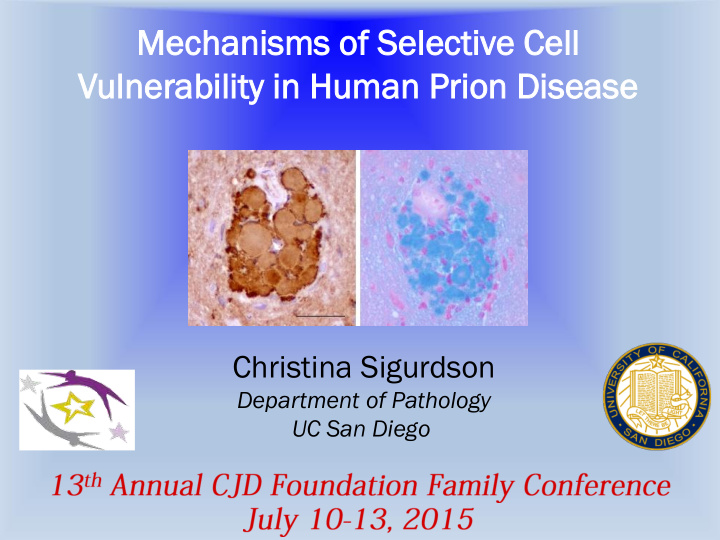



Mec echanisms hanisms of Sel electiv ective e Cell ell Vul ulnerability erability in Hum uman an Prion ion Disease ease Christina Sigurdson Department of Pathology UC San Diego
Protein misfolding and aggregation is a common feature of neurodegeneration Alzheimer Parkinson Amyotrophic Creutzfeldt-Jakob Huntington lateral sclerosis PrP Sc plaques Amyloid- b plaques a -synuclein Ubiquitin inclusions Poly-Q inclusions cortex substantia nigra spinal cord cerebellum striatum Modified from Forman et al, Nature Medicine, 2006
Prion conformational subtypes: Distinct disease phenotypes occurring in patients Subtype 1 Subtype 2 distinct conformations
Human prion disease: prion plaques vary in morphology and cells targeted 2 1 3 Sporadic CJD vCJD Plaque deposits Perineuronal deposits Plaques
Prion protein aggregates vary by morphology and cells targeted in mice 22L Me7 RML mCWD
What mechanism underlies the selective cell vulnerability in prion disease?
Heparan sulfate proteoglycans and prion pathogenesis COOH CH2OH/SO3 • Diverse glycoproteins on cell surfaces and in OH OH/SO3 O the extracellular matrix O OH/SO3 NH/Ac/SO3/H Promotes the internalization of PrP C and • propagation of PrP Sc HS chain Core protein • Prolongs prion disease in scrapie-infected rodents
Hypothesis: PrP Sc interaction with heparan sulfate proteoglycans is a major determinant underlying prion cell tropism
Defining the HS molecules associated with the most common human CJD subtypes 2) Identify the PrP Sc bound heparan 1) Purify PrP Sc from 3 brain regions sulfate by liquid chromatography-mass Prion-infected brain spectrometry (LC/MS) * * * purification Quantify N-SO 3 , 2-O-SO 3 , 6-O-SO 3 groups and N-acetylated, N-sulfated and N-unsubstituted glucosamine residues Amyloid β : cerebral amyloid angiopathy (CAA) GlcNH2 3 2 mol (%) 1 0 CAA pos CAA neg HE IHC Congo red
How does the sulfation of HS molecules impact prion replication? PrP C produced in RK13 cells • Glycosylated • GPI-anchored • 3F4-tag Different variably Seed Heparan sulfate sulfated HS PrP Sc Increase in PrP C PrP SC Detection of new PrP Sc Sonication using 3F4 tag Amplification Fragmentation of misfolding of aggregates creates new seeds
Heparin and pentosan polysulfate enhance prion conversion in a dose-dependent manner
Heparin and PPS lead to a decrease PrP Sc levels in persistently prion-infected cells Demonstrates the paradoxical effect of HS – in cell lysate amplification versus in live cells and in vivo
The impact of sulfation of HS chains on prion disease progression Wild type Ext1+/- : shorter HS mice chain length Terminal Challenge with prions disease 50% 75% Analysis of brain Histopathology Biological properties Biochemical properties Ongoing……
Conclusions • PrP Sc purified for mass spectrometry analysis to identify the heparan sulfate bound to PrP Sc • Pentosan polysulfate promotes PrP Sc formation in vitro in the PMCA assay • Heparin and pentosan polysulfate decrease PrP Sc levels in prion-infected cells in culture
Acknowledgements UC San Diego Patricia Aguilar-Calvo Case Western Reserve University Tim Kurt Witold Surewicz Cyrus Bett Patricia Gaffney Jun Liu Peter Kobalka Katrin Soldau Jeff Esko Chrissa Dwyer National Institutes of Health, NINDS Creutzfeldt-Jakob Disease Family Foundation
Recommend
More recommend